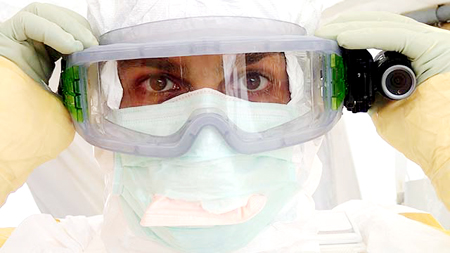Dr Mohammad Ashraf
Ebola virus disease (EVD) is one of the dreaded re-emerging diseases that causes haemorrhagic fever in humans and animals. This diseases causes haemorrhagic fevers culminating into significant internal bleeding a path announcing the impending doom up to the 70% of cases. Ebola virus disease is basically a zoonotic disease but humans can contract the disease from infected animals. Ebola Virus epidemic is now rearing its ugly head in Asian countries including ours, already devastating the West African countries beyond human imagination. Epidemiologists are of the notion of exponential growth of EVD and recommend that health-sector of every country must be proactive to stop EVD spread. Joseph Lewnard and colleagues (Infectious Diseases specialists of international repute) developed a mathematical model to predict the transmission of Ebola virus disease (EVD) in the form of basic reproductive numbers (R0) and estimated; if R0 in a region is around 2·5, incidence in every successive epidemic generation will increase by 150%. If R0 could be pushed to less than one, incident case counts would begin to drop, but because incident cases are a function of prevalent cases, making this decrease happen earlier in the epidemic results in striking reductions in final epidemic size and they opined that having a nap could steal the lives of millions.
Mode of spread
The Ebola virus can spread through contact with infected animals, contact with blood, body fluids or tissues of infected persons, contact with medical equipment, such as needles, contaminated with infected body fluids. Exposure can occur in health care settings when staff do not wear appropriate personal protective equipment, such as masks, gowns, goggles, suits, boots and gloves. As long as precautions are taken, there is low risk of contracting EVD in a country where the disease is present.
Risk Factors
The risk increases if you: 1. visit or work in areas where Ebola virus or Marburg virus outbreaks have occurred. 2. Conduct animal research in the Ebola or Marburg virus endemic areas. 3. Provide medical or personal care to the affected/deceased ones while not observing the universal precautions.
Symptoms
As per New England Journal of Medicine, Oct 16, 2014; the most common symptoms reported between symptom onset and case detection included fever, fatigue, loss of appetite, vomiting, diarrhea, headache, and abdominal pain. Specific hemorrhagic symptoms were rarely reported (in <1% to 5.7% of patients). “Unexplained bleeding,” however, was reported in 18.0% of cases. These patterns are similar in all afflicted countries. Approximately 95% of the patients had symptom onset within 21 days after exposure to an infected person, which is the recommended period for follow-up of contacts. The initial clinical presentation is non-specific, so viral haemorrhagic fever should be considered in any patient with a fever or history of fever in the previous 24 hours who has returned from an endemic area in the past 21 days. So do not miss travel history becomes an important questions that otherwise is rarely elicited in most day to day consultations, leading to delays in diagnosis and in the isolation of patients at risk
Complications
As the illness progresses, it can cause: multiple organ failure, severe bleeding, jaundice, delirium, seizures, coma and shock. Survivors may take months to regain weight and strength, and the viruses remain in the body for weeks and these patients may experience: hair loss, sensory changes, liver inflammation, weakness, fatigue, headaches, eye inflammation and testicular inflammation.
Case Management
The international guidelines recommend that patients having a possible viral haemorrhagic fever should be isolated until the results of specific investigations are obtained from reference laboratories, which may take up to 24 hours. It is important not to delay diagnosis and treatment of more common diseases during this period. The updated guidelines recommend that under all universal precautions it is safe to perform basic tests locally to support clinical management while awaiting the results of specific diagnostic tests.
Control measures
The Centers for Disease Control and Prevention recommends that there should be improvements in contact tracing, adequate case isolation, increased capacity for clinical management, safe burials, greater community engagement, and support from international partners failing which whole of the world may be flooded with the Ebola tsunami.
Conclusion
The risk of a traveler acquiring a viral haemorrhagic fever and importing it here in our state is small but heightened awareness must be observed. The key message for healthcare professionals is to take a travel history from all patients with fever and perform a more specific risk assessment for patients returning from areas endemic for these diseases, according to the recently updated international guidelines. Alarm bells have already gone off for all apex hospitals to be ready to come to grasp with Ebola tsunami. These institutions should: a) spare few special/isolation beds, b) train healthcare providers, c) formulate management protocols and must get personal protective equipments to free the mankind from the jaws of death.
(The author is Consultant Pediatric Nephrology, GB Pant Hospital Govt Medical College Srinagar)
Trending Now
E-Paper


